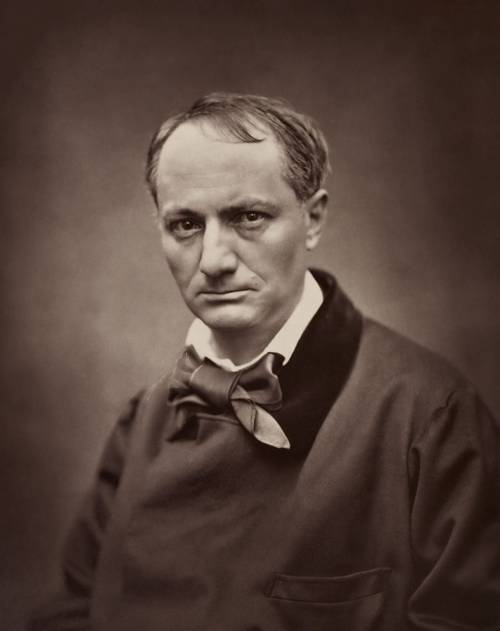
FAQ About Charles Baudelaire

Who is Charles Baudelaire?
Charles Baudelaire was a French poet born on April 9, 1821, in Paris. He is best known for his groundbreaking collection of poems, Les Fleurs du Mal (The Flowers of Evil), published in 1857. Baudelaire's work is celebrated for its exploration of themes like beauty, decadence, and the grotesque, and he is considered a significant figure in the transition to modern poetry.

What is 'Les Fleurs du Mal'?
Les Fleurs du Mal (The Flowers of Evil) is a collection of poems by Charles Baudelaire, first published in 1857. The collection is noted for its highly original style, dealing with themes such as eroticism, death, rebellion, and the passage of time. It was both praised and criticized for its stark depictions of life and morality, leading to a trial for obscenity shortly after its release.

Why was Baudelaire's 'Les Fleurs du Mal' considered controversial?
'Les Fleurs du Mal' was considered controversial due to its candid explorations of themes such as sexuality, decay, and the macabre, which were deemed morally offensive in mid-19th century France. The French government prosecuted Baudelaire, resulting in a fine and the suppression of six poems. Despite this, the work established his legacy as a revolutionary figure in literature.

How did Baudelaire influence modern poetry?
Charles Baudelaire is credited with transforming modern poetry through his innovative use of language and exploration of themes that challenged traditional norms. His work laid the groundwork for symbolist and modernist movements, inspiring poets such as Stéphane Mallarmé, Arthur Rimbaud, and later T.S. Eliot. Baudelaire's emphasis on capturing fleeting moments, urban life, and psychological depth resonated profoundly with future generations.

What are the main themes in Baudelaire's poetry?
Baudelaire's poetry often explores themes of beauty amid decay, the juxtaposition of the sacred and the profane, existential ennui, and the search for transcendence through art. His work also delves into the complexities of human emotion, the role of the artist, and societal critiques, often delivered with a sense of irony and lyrical intensity.

When was Charles Baudelaire's most active period as a poet?
Charles Baudelaire's most active period as a poet was during the mid-19th century, particularly from the 1840s to the 1860s. His most famous work, Les Fleurs du Mal, was published in 1857, marking a pinnacle in his literary career.

What impact did Baudelaire's upbringing have on his work?
Baudelaire's upbringing had a significant influence on his work. He experienced a turbulent childhood, including the death of his father when he was six, and a strained relationship with his stepfather. These experiences contributed to themes of alienation, nostalgia, and rebellion against traditional authority present throughout his poetry.

Did Charles Baudelaire face any legal issues because of his work?
Yes, Charles Baudelaire faced legal issues due to the publication of Les Fleurs du Mal. In 1857, he was prosecuted for obscenity and blasphemy due to the provocative nature of the themes in his poems. As a result, six poems were banned and Baudelaire was fined, although he later regained partial rights to rework the collection.

What is the style of Baudelaire's writing?
Baudelaire's writing style is characterized by its rich symbolism, lyrical intensity, and exploration of urban modernity. He employed a variety of meters and rhyme schemes, which, combined with his vivid imagery and philosophical depth, helped capture the complexity of contemporary life. His style is also notable for its tendency to blur the line between beauty and the grotesque.

How did Baudelaire's work influence later literary movements?
Baudelaire's work significantly influenced literary movements such as Symbolism and Modernism. His use of imagery and themes of existential despair and the search for beauty within darkness resonated with future writers who sought to challenge traditional forms. His influence is seen in the works of poets like T.S. Eliot and the emergence of the stream of consciousness technique in literature.

What other works did Baudelaire produce apart from 'Les Fleurs du Mal'?
Besides Les Fleurs du Mal, Baudelaire produced several notable works. These include the prose poems Le Spleen de Paris (Paris Spleen), the art criticism essays Curiosités esthétiques, and translations of Edgar Allan Poe’s work, which introduced Poe's macabre storytelling to French audiences.

What is 'Le Spleen de Paris'?
Le Spleen de Paris (Paris Spleen) is a collection of 50 prose poems by Baudelaire. Published posthumously in 1869, it builds on themes from Les Fleurs du Mal and is known for its exploration of the fragmented and ephemeral nature of urban life. These prose poems are notable for their innovation in form and ability to capture the fleeting essence of modern existence.

Was Baudelaire associated with any literary movements during his lifetime?
During his lifetime, Baudelaire was associated with the early Symbolist movement. While he didn't explicitly belong to any literary group, his work influenced Symbolism with its focus on subjectivity, metaphorical language, and exploration of themes beyond the literal. He bridged the gap between Romanticism and the burgeoning Symbolist movement, inspiring many subsequent writers.

Where did Charles Baudelaire spend most of his life?
Charles Baudelaire spent most of his life in Paris, France. The city played a pivotal role shaping his artistic perspective, providing both the backdrop for his writing and a source of inspiration for his evocative portrayal of urban existence. His deep connection with the city is evident in much of his poetry.

How did Baudelaire's translations of Edgar Allan Poe influence his writing?
Baudelaire's translations of Edgar Allan Poe's works profoundly impacted his writing, providing him with stylistic and thematic inspiration. Poe's exploration of dark and complex themes resonated with Baudelaire, who admired his ability to delve into the human psyche and confront existential dread. These translations helped cement Baudelaire's reputation as an intermediary bringing Poe's work to a wider French audience.

What were Baudelaire's views on modernity?
Baudelaire had a complex relationship with modernity, viewing it as both a source of alienation and inspiration. He recognized the beauty and decay of modern life, capturing its ephemeral nature through his poetry. Baudelaire celebrated the new urban experience while also critiquing its dehumanizing effects, seeking to portray the balance between progress and tradition.

How did Baudelaire's health impact his life and work?
Baudelaire's health issues greatly affected his life and work. He suffered from various ailments, including syphilis and depression, which influenced his themes of suffering and the darker aspects of human existence. His declining health in his later years contributed to a sense of urgency and despair in his writing, reflecting his personal struggles with illness and mortality.

What influenced Baudelaire's writing apart from Poe?
In addition to Edgar Allan Poe, Baudelaire was influenced by a variety of sources. Romantic poets like Victor Hugo inspired his early work, while his fascination with Gothic art, philosophy, and contemporary Parisian life added depth and breadth to his themes. His personal experiences, including his tumultuous relationships and existential inquiries, also significantly shaped his writing.

Did Charles Baudelaire have any notable relationships that influenced his work?
Baudelaire had several significant relationships that influenced his work, including his bond with his mother, which was both loving and contentious, and his relationships with several women, such as courtesan Jeanne Duval. These relationships often inspired his exploration of intense emotions and complex human interactions in his poetry.

What is Charles Baudelaire's legacy in literature?
Charles Baudelaire's legacy in literature is profound, as he is regarded as one of the pioneers of modern poetry. His innovative use of language, exploration of complex themes, and his role in bridging Romanticism and Symbolism have left an indelible mark on literary history. His work continues to influence poets, writers, and scholars, maintaining a vital presence in the study of poetry and literary theory.
